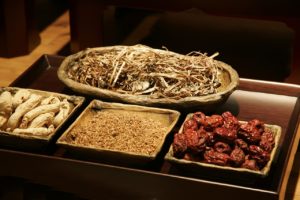 Traditional Chinese medicine (TCM) is a 2,500-year-old system of diagnosis and treatment that emphasizes the prevention of diseases. TCM medicines are tailored to each individual and may need to be altered from time to time, therefore, patients are encouraged to see their TCM doctor frequently. After the fall of the Qing dynasty in 1911, TCM was regarded as superstition but in recent years the practice has seen an increase in popularity. An interest in preventative medicine as a way to avoid costly trips to the hospital as well as President Xi Jinping’s endorsement of it, calling it “the gem of Chinese traditional science,” have contributed to its popularity. In 2015 there were 452,000 licensed practitioners in China, an increase of 50% from four years prior. One-third of China’s pharmaceutical market consists of TCM medicines approved by the government.
Traditional Chinese medicine (TCM) is a 2,500-year-old system of diagnosis and treatment that emphasizes the prevention of diseases. TCM medicines are tailored to each individual and may need to be altered from time to time, therefore, patients are encouraged to see their TCM doctor frequently. After the fall of the Qing dynasty in 1911, TCM was regarded as superstition but in recent years the practice has seen an increase in popularity. An interest in preventative medicine as a way to avoid costly trips to the hospital as well as President Xi Jinping’s endorsement of it, calling it “the gem of Chinese traditional science,” have contributed to its popularity. In 2015 there were 452,000 licensed practitioners in China, an increase of 50% from four years prior. One-third of China’s pharmaceutical market consists of TCM medicines approved by the government.
Today’s market size shows the number of hospitals in China that offered TCM either alone or in conjunction with modern medicine in 2003 and 2015.
Geographic reference: China
Year: 2003 and 2015
Market size: 2,500 and 4,000 respectively
Source: “Health Care With Chinese Characteristics,” The Economist, September 2-8, 2017, pages 37-38.
Image source: mac8739, “chinese-medicine-donguibogam-2178253,” Pixabay, April 2017 available online here.
